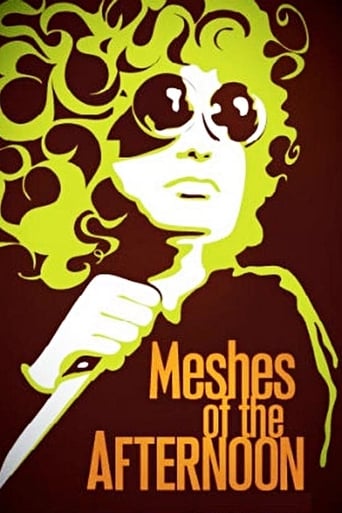Becky (rwbeee6749)
Cinematic art like "Meshes of the Afternoon" has no single definitive meaning, but rather scores of meanings that differ from viewer to viewer.To me, the most telling symbols in the film were:the bread knife, a possible phallic symbol which moves seemingly on its own and evokes a feeling of encroaching dangerthe ominous black figure with a mirror for a face (part of the subject's consciousness, perhaps her future self, like the Ghost of Christmas Future)the phone left off the hook (desires and intentions left unsaid and unfulfilled)
punishmentpark
A wonderful short film that I stumbled upon via a little gif on Tumblr (the key turning into a knife). This a dark, artful piece about a woman who is / gets caught in a time-loop. The outcome is that she is finally found dead (suicide, probably) by a man, most likely to be her lover. One could interpret her going round and round in circles in more than one way, I suppose. My main idea is that, while she is dead, her soul / ghost is trying to figure out where it / she is. Or what it / she is, namely dead. Just my two cents, though. It also reminds me of the later giallo genre, at certain moments, especially when Maya Deren's face is reflected in the blade of the knife.Even without a perfectly reasonable explanation, one can still enjoy all the wonderful and mysterious, but at many times quite eerie, imagery of some Hollywood apartment block (inside and outside) knives, stairs, (broken) mirrors, black robes, keys, and such. The soundtrack, the original one by Teiji Ito, is just as wonderful, with some soothing acoustic guitars here and there, but also with a lot of haunting voices and percussion.For now, a big 9 out of 10. Note to self: watch more work by Maya Deren (and what a beauty she is, by the way)!
invaderJim
I do not think this is one of her best works, as it is often cited to be. It's technically astounding, filled with interesting shots and effects. But for all her attempts to embrace surrealism she clings to the necessity of the narrative, an experiment that (for my taste) has only been successfully attempted by Bunuel and Bergman, and to a lesser degree Tarkovsky. There are also a lot of interesting images, the cloaked antagonist with a mirror for a face stands out, but it remains a sort of Frankenstein's monster of cinema, halfway between the real and surreal without the necessary components to integrate the two. Still quite enjoyable though.
ackstasis
The most striking image of 'Meshes of the Afternoon (1943)' is that of Maya Deren trapped behind glass, staring mournfully outside, her hands pressed up against the reflection of trees outside her window. The sensation of being "trapped" within one's own household must have been common for many wives during the 1940s, particularly given that most husbands were abroad fighting for their country. This film, co-directed by Deren and her then-husband Alexander Hammid, to me seems to depict a woman confined within an apathetic marriage. Arriving home, Deren's initially-faceless woman collects a solitary flower from the footpath, grasping for a hint of romance in her otherwise dreary existence. A phone hangs off its hook, implying the disconnection between husband and wife. A key transforms into a kitchen knife, and vice versa. Trapped within this loveless marriage, Deren contemplates two courses of action to free herself from these martial bonds: kill her husband, or kill herself. When she attempts the former act, Hammid's face fragments like a mirror image, as though (in the male-dominated 1940s) to destroy her husband would leave Deren without an identity of her own. While contemplating her own suicide, Deren dreams of a mirror-faced Grim Reaper whom she chases, to no avail, down the path, before attempting to stab herself as she sleeps (alternatively, the Reaper-like figure resembles the sombre attire of a widow, perhaps reiterating the former action).The directors' manipulation of space and orientation is masterfully orchestrated, with ordinary rooms photographed to feel intensely claustrophobic; even a simple staircase suddenly seems an insurmountable foothill as Deren claws her way up. There's no doubt that Deren and Hammid were influenced by the cinema of Georges Méliès, whose filmed "magic shows" similarly used jump cuts to create a disjointed sense of reality. Particularly fascinating about 'Meshes of the Afternoon' is how it seamlessly integrates dreams and reality, each plane of existence inescapably influencing and merging with the other. Though the film was originally released silent, in 1959 Deren's third husband Teiji Ito scored a Japanese-inspired soundtrack, which, like the film, is cyclical and repetitive.



